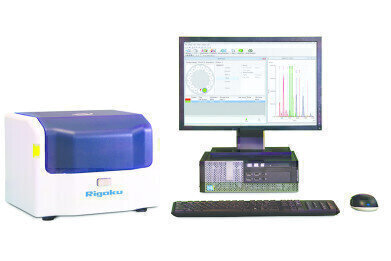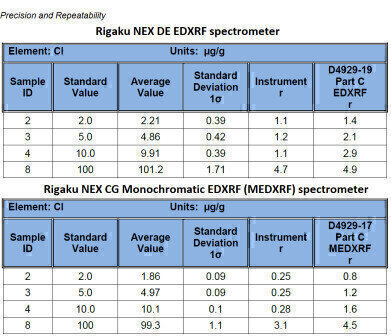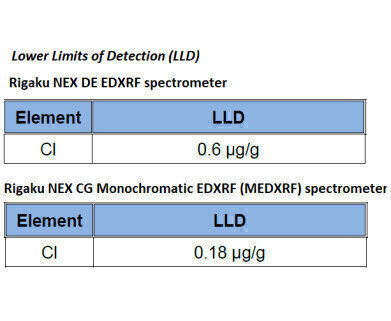Analytical Instrumentation
Organic Chloride in Crude by ASTM D4929 Part C
Jan 22 2020
Scope
ASTM D4929 is the Standard Test Method for Determination of Organic Chloride Content in Crude Oil. Procedure C covers the measurement of organic chloride in the washed naphtha fraction of crude oil by X-ray fluorescence spectrometry.
The analysis of organic chloride in crude is demonstrated per ASTM D4929 Part C, whereby the peak intensity of the chlorine Kα line of the washed naphtha fraction of a crude oil specimen is measured by energy dispersive X-ray fluorescence (EDXRF) spectrometry or by monochromatic energy dispersive X-ray fluorescence (MEDXRF).
Background
Chlorides in crude contribute to corrosion in the piping at refineries during cracking as well as mid-stream in pipelines. Organic chlorides do not naturally occur in crude, however inorganic chlorides in the form of salts as well as residual organic chlorides from various natural sources as well as adulteration can contaminate crude. Contracts at the pipelines may contain clauses limiting the amount of organic chloride allowed in the crude. And at the refinery after desalting and desulfurisation, crude needs to be analysed for any residual organic chlorides possibly still entrained in the feedstock to avoid potential damage during the refining process.
Instrumentation
- Type: EDXRF
- Model: Rigaku NEX DE
- X-ray tube: 12W Ag-anode
- Detector: SDD
- Sample tray: 15-position Austosampler
- Film: Polypropylene (4um)
- Analysis Time: 300 sec
- Environment: Helium
- Type: Monochromatic EDXRF (MEDXRF)
- 90â—¦ Cartesian Geometry Polarisation
- Model: Rigaku NEX CG
- X-ray tube: 50 W Pd-anode
- Detector: SDD
- Sample tray: 15-position Austosampler
- Film: Polypropylene (4um)
- Analysis Time: 300 sec
- Environment: Helium
Sample Preparation
ASTM D4929 is designed for the measurement of residual organic chlorides in crude. The crude sample is first prepared by distillation and wash to remove H2S and inorganic chlorides. After distillation and wash processes the resulting naphtha fraction is analyzed for Cl content by XRF using Part C methodology. The naphtha fraction is typically stable containing less than 1000 μg/g S. XRF calibration is made using mineral oil calibration standards, as mineral oil models naphtha for X-ray response.
To prepare a sample for XRF analysis simply place 4.0g of the naphtha sample in a standard 32mm XRF sample cup and measure directly.
ASTM D4929 Calibration - Part C XRF
Empirical calibration was made using commercially available mineral oil standards. For optimum calibration the standards contain both S and Cl, with S content ranging from 100 to 1000 μg/g. Alpha corrections are automatically employed to compensate for sulfur's effect on chlorine X-rays.
Calibration
Both sulfur and chorine are measured during calibration. The sulfur measurement is used to optimize the measurement of the chlorine, to compensate for the effect of sulfur's absorption of chlorine X-rays.
Precision & Repeatability
To demonstrate recovery, precision and repeatability of the measurement, a few calibration standards were selected with results shown in the accompanying tables.
Detection Limits
The empirical method is used to determine detection limits using 300 sec measurement time. Ten repeat analyses of a blank mineral sample are taken with the sample in static position and the standard deviation (σ) is determined. The Lower Limit of Detection (LLD) is then defined as three times the standard deviation (3σ).
(See LLD tables)
Conclusion
The Rigaku NEX DE EDXRF spectrometer offers excellent performance for the measurement of organic chloride in crude per ASTM D4929 Part C. Compact, and suitable for use in the field or at refineries, the analyser also complies with many other ASTM and ISO methods for critical measurements in the petroleum industry, making it an excellent choice as a multi-purpose analyser in the petroleum industry.
The Rigaku NEX CG elemental analyser, using 90º Cartesian Geometry polarisation monochromatic EDXRF, gives superior performance for the measurement of organic chloride in crude as per ASTM D4929 Part C. The NEX CG analyser also complies with many other ASTM methods and EPA requirements for critical measurements in the petroleum industry, making it an excellent choice as an all-in-one analyser for measuring sulfur and ultra-low sulfur, metals in crude and residual oil, and lube oils.
Digital Edition
PIN 25.1 Feb/March
March 2024
In This Edition Safety - The technology behind the ION Science Tiger XT - Safety with ammonia and LOHCs as hydrogen carriers Analytical Instrumentation - Discussion on new tribology te...
View all digital editions
Events
Apr 28 2024 Montreal, Quebec, Canada
Apr 30 2024 Birmingham, UK
May 03 2024 Seoul, South Korea
May 05 2024 Seville, Spain
May 06 2024 Riyadh, Saudi Arabia




















